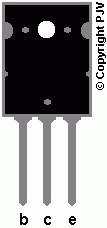How to Check Transistors
Testing a bipolar junction transistor is a diagnostic methodology used in the field of electronic engineering. It helps to determine whether a transistor is faulty. There are two methods for testing a transistor, the simplest is an automatic test carried out by the meter with the transistor test setting. An alternative method is manually testing each pair of junctions using the diode test setting.
Resistance Test
It is also possible to use the resistance setting of the meter; however, it can be confusing to a beginner if the meter gives a reading of a few thousand ohms in both directions. Usually, the resistance setting does not produce sufficient voltage to forward bias the junction, and therefore more experience is required to interpret the resistance readings. Usually, a high resistance in one direction and a low resistance in another indicate a good junction. For beginners, it might be confusing to interpret the resistance readings especially when the values have a few ohms difference.
Diode Test
The diode test is usually more useful as the majority of the meters display a "1" which indicates out of range for reverse bias mode. When connected in the forward biased direction the meter displays a forward bias voltage reading, indicating conduction. Hence, if you were testing a pair of junctions, you would expect it to conduct in one direction and display a forward bias voltage reading, and with the test probes reversed, it should display "1".
Continuity Buzzer
A continuity buzzer setting is also a reliable indicator for detecting shorts in a power transistor. When power transistors go short, there is very little resistance between the junctions, and a buzzer will make a nice loud sound when connected to the junctions in either direction indicating a short.
General Rule of Thumb to Detect Shorts
With experience, you eventually realise that it does not matter whether the transistor is a PNP type, or NPN type. It also does not matter which terminals are base, collector, and emitter. Usually when testing a bipolar junction transistor (BJT), no pair of junctions should conduct in both directions. If you find any two junctions conducting in both directions, then you have discovered a faulty transistor that is short. However, this is the difference between experience, and theory.
General Rule of Thumb to Detect Opens
Detecting an open junction is a little trickier, but not impossible. Usually, a bipolar transistor will have one pair of leads that will not conduct in either direction. This pair consists of the emitter and collector junctions. Hence, in a good transistor, you should expect one pair of junctions behaving in this way, and that is fine. However, if you had two pairs of junctions behaving in this way, then you have at least one open, and that indicates a faulty transistor.
Experienced Tester
An experienced electronic engineer can usually test a transistor manually simply using the diode test mode. Usually a proficient engineer can successfully identify a faulty transistor within seconds. I remember one engineer in Asia who could identify a faulty transistor in ten seconds using just a simple meter. She would throw it back on the table and say whether it was good or bad and she was right every time.
Alto PBM8 500 MKII Power Transistors
In this example, I tested the power transistors from a PBM8-500 MKII amplifier and this is what I found. In a good transistor, the emitter-collector junctions will not conduct in either direction. However, in a shorted transistor, they do.
The base-collector junctions should conduct in only one direction but not another. If they conduct in both, then it is short, and if they do not conduct in either direction, then it is open. The base-emitter junctions should conduct in only one direction. If it conducts in both directions then it is short.
Below there are four charts which show how a PNP transistor and its complementary NPN transistor conducts between each terminal.
2SC5200 / GCA5200T NPN Transistor Test

| Positive | Negative | Good Transistor | Bad |
| Base | Collector | Conducts | Conducts |
| Collector | Base | Should not conduct | Conducts |
| Collector | Emitter | Should not conduct | Conducts |
| Emitter | Collector | Should not conduct | Conducts |
| Base | Emitter | Conducts | Conducts |
| Emitter | Base | Should not conduct | Conducts |
2SA1943 / GCA1943T PNP Transistor Test

| Positive | Negative | Good Transistor | Bad |
| Base | Collector | Should not conduct | Conducts |
| Collector | Base | Conducts | Conducts |
| Collector | Emitter | Should not conduct | Conducts |
| Emitter | Collector | Should not conduct | Conducts |
| Base | Emitter | Should not conduct | Conducts |
| Emitter | Base | Conducts | Conducts |
MJE15033G PNP Transistor Test

| Positive | Negative | Good Transistor |
| Base | Collector | Should not conduct |
| Collector | Base | Conducts |
| Collector | Emitter | Should not conduct |
| Emitter | Collector | Should not conduct |
| Base | Emitter | Should not conduct |
| Emitter | Base | Conducts |
MJE15032G NPN Transistor Test

| Positive | Negative | Good Transistor |
| Base | Collector | Conducts |
| Collector | Base | Should not conduct |
| Collector | Emitter | Should not conduct |
| Emitter | Collector | Should not conduct |
| Base | Emitter | Conducts |
| Emitter | Base | Should not conduct |
This Article Continues...
PBM8 500 MKIIPBM8 500 MKII Inside Look
PBM8 500 MKII Diagnostic Logic
PBM8 500 MKII Fault Solved!
Power Resistor
Amplifier Heat Sink
Class AB Amplifier
How to Check Transistors
GCA5200T and GCA1943T Transistors
2SC5200 2SA1943 Transistor Replacement
PBM8 500 MKII Diagnostic LEDs
PBM8 500 MKII Power Supply